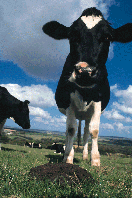|
[ Chapter 8: Example 1 ]
BSE - A difficult risk to manage
BSE (Bovine Spongiform Encephalopathy) is a disease of cattle which was first identified in 1986. It causes microscopic holes in the brains of affected animals. These animals become uncoordinated, nervous and eventually die. CJD (Creutzfeldt Jakob Disease) is a very rare human disease. It affects about one person in a million each year. There is no conclusive scientific proof of a connection between BSE and CJD. In March 1996, a new variant of the disease was identified. This differs from the usual sporadic form, because it affects younger people (this may change with time) but primarily because the clinical features and pathological changes in the brain were unique. As at 1 November 1996, 14 such cases had been identified in the UK and one in France.
|

|
Since 1986, extensive scientific research has been sponsored by the UK Government, based on the advice from several scientific committees with remits of animal and human health. Fifty-seven pieces of legislation have been enacted in the UK since 1988. The European Commission has also legislated on BSE since 1989.
Chris Martin, Environmental images
|
The UK Government has made risk management decisions based on the scientific consensus at the time. Ultimately, the decisions were made within a framework that considered the implications for the UK beef industry and farmers' interests. Scientific disagreement over the extent of the BSE infection, transmission routes of BSE infection and the reality of the threat to human health fuelled the controversy in the media.
The crisis came to a head when the EU banned the importation of British beef in response to evidence of a possible link between BSE and CJD. Action in the UK was based on the scientific advisory group's advice at that stage, based on the scientific evidence and the crisis in consumer confidence. This included a ban on the sale of cattle over 30 months old and a slaughter programme.
The UK Government characterised the European decision as being taken on non-scientific grounds. The lack of scientific certainty and "proof" have coloured public perception of risk. The BSE crisis in the UK demonstrates that whether experts and policy makers believe that the public have an irrational view of risk, irrational or not, it cannot be ignored. The consuming public had taken a view on the BSE issue. Beef sales in the UK and Europe fell dramatically. The case of BSE highlights the immense difficulties in attempting to make public policy decisions using immature scientific data. Such decisions still have to be made, however, in the absence of hard evidence, and at that point it is the translation of science, policy and perceived risk into public statements that need careful consideration.
|

Document Actions
Share with others